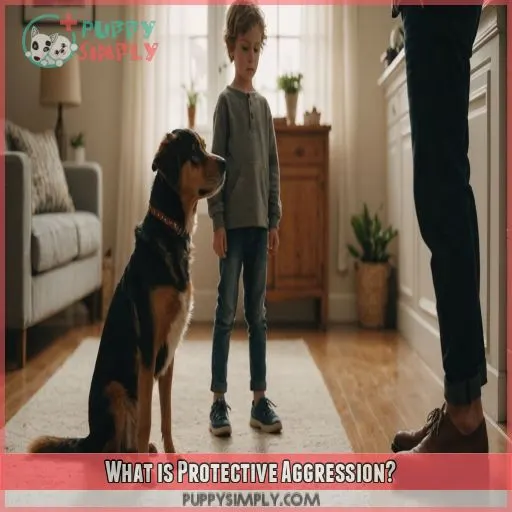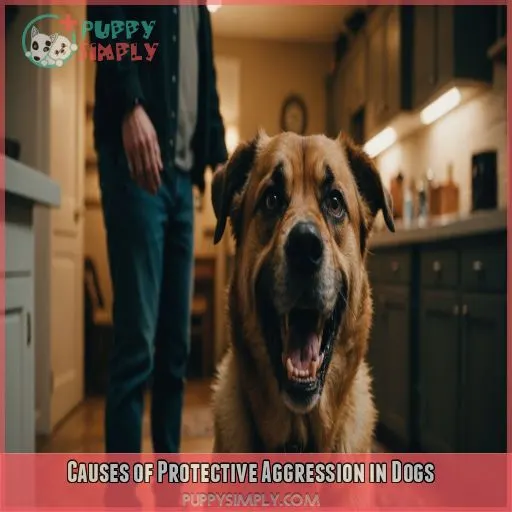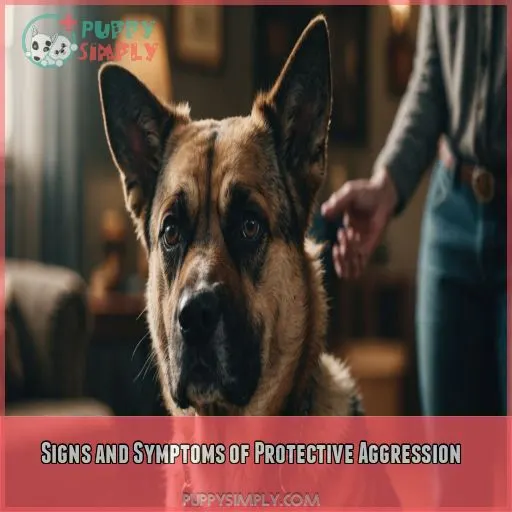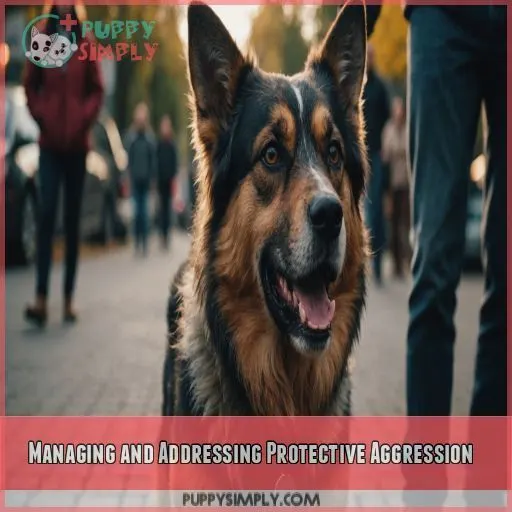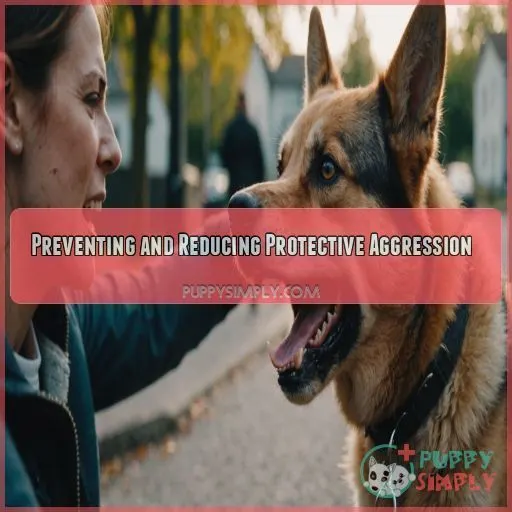This site is supported by our readers. We may earn a commission, at no cost to you, if you purchase through links.
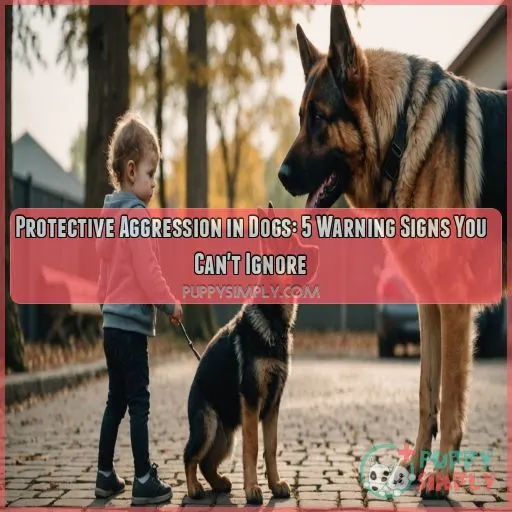
So, what is protective aggression in dogs?
Simply put, it’s when your dog becomes defensive to protect you, their territory, or resources.
You might notice direct stares, raised hackles, growling, or even showing teeth.
But here’s the thing: it’s not just about being possessive or dominant.
Fear, anxiety, and past experiences can trigger this behavior too.
By understanding what drives your dog’s protective aggression, you can take the first steps towards addressing it.
And that’s a pretty powerful feeling.
Table Of Contents
- Key Takeaways
- What is Protective Aggression?
- Causes of Protective Aggression in Dogs
- Signs and Symptoms of Protective Aggression
- Managing and Addressing Protective Aggression
- Preventing and Reducing Protective Aggression
- Frequently Asked Questions (FAQs)
- How do dogs differentiate between threats and non-threats to family?
- Can training reduce protective aggression in older dogs effectively?
- Do specific breeds exhibit more protective aggression than others?
- Can dogs develop protective aggression due to past trauma?
- Is protective aggression more common in multi-dog households?
- Conclusion
Key Takeaways
- You’re not alone in dealing with protective aggression – it affects up to 20% of dogs. By recognizing the warning signs and understanding what drives this behavior, you can take proactive steps to address it and help your dog feel more secure.
- Your dog’s past experiences, fear, and anxiety can trigger protective aggression, so it’s essential to consider their emotional state when addressing this behavior. By using positive reinforcement training, desensitization, and counterconditioning techniques, you can help your dog associate perceived threats with positive outcomes.
- You can reduce protective aggression in your dog by making a few simple changes to their environment, exercise routine, and training. Spaying or neutering, creating safe spaces, and providing proper exercise and mental stimulation can all help lower the risk of protective aggression.
- Don’t worry if your dog is exhibiting protective aggression – with patience, persistence, and the right training, you can help them feel more secure and reduce this behavior. Remember to consult a professional dog trainer or behaviorist for personalized guidance, especially if your dog’s protective aggression persists or worsens.
What is Protective Aggression?
When your furry friend starts growling or snapping at strangers, you might wonder if they’re just being protective or if there’s something more going on. Let’s break down what protective aggression is and how to spot it in your dog, so you can keep them (and others) safe and happy.
Definition and Explanation of Protective Aggression
You’re probably wondering, what’s protective aggression in dogs? Simply put, it’s when your furry friend becomes defensive to protect you, their territory, or resources. Here are three common triggers:
- Perceived threats: Your dog may growl or snap when approached by strangers or other animals.
- Resource guarding: They might defend their food, toys, or space.
- Territorial protection: Your dog may become aggressive when someone enters their territory.
Differences Between Fear-Based and Dominance-Based Aggression
Let’s break down the differences between fear-based and dominance-based aggression. Fear-based aggression stems from anxiety and insecurity, often triggered by specific situations or objects. Dominance-based aggression, on the other hand, is driven by a desire to assert control and power. Understanding these underlying motivations is key to addressing protective aggression in dogs and implementing effective training methods.
How to Identify Protective Aggression in Dogs
As you observe your dog’s behavior, identifying protective aggression is important. Watch for these red flags:
- Direct stares: Your dog locks eyes with a stranger, and their body stiffens.
- Raised hackles: Their fur stands on end, and they growl or show teeth.
- Blocking access: They position themselves between you and a perceived threat, ready to defend.
Causes of Protective Aggression in Dogs
When trying to understand why your dog is showing protective aggression, it’s important to think about the underlying causes that might be triggering this behavior. By recognizing the root causes, such as fear and anxiety triggers, territoriality, past experiences, and genetic predisposition, you can take the first step in addressing and managing your dog’s protective aggression.
Fear and Anxiety Triggers
Now that you understand what protective aggression is, let’s explore what triggers it. Fear and anxiety can spark protective aggression in dogs. Think of it like a big, furry, fight-or-flight response. Here are some common triggers:
| Trigger | Example |
|---|---|
| Separation anxiety | Leaving your dog alone for the first time |
| Loud noises | Fireworks or thunderstorms |
| Unexpected guests | Surprise visitors at the door |
| New environments | Moving to a new home or park |
Territoriality and Resource Guarding
Now that you’ve got a handle on fear and anxiety triggers, let’s talk about another common cause of protective aggression in dogs: territoriality and resource guarding. Think of it like this: your dog is protecting their "stuff" – food, toys, space – from perceived threats. Watch for resource guarding cues like growling or stiffening when you approach their favorite things.
Past Experiences and Trauma
Your dog’s past experiences can shape their behavior, especially regarding protective aggression. Trauma, abuse, or neglect can lead to deep-seated fear and anxiety. If your furry friend has a history of:
- Being a rescue from an abusive situation
- Suffering from PTSD
- Experiencing neglect or abandonment
- Witnessing violence or aggression
their protective aggression may be a coping mechanism.
Genetic Predisposition to Aggression
You’ve explored how past experiences can shape your dog’s behavior, but what about the role of genetics?
Research suggests that breed-specific aggression can be inherited, with certain breeds more prone to protective aggression due to their original purpose, such as guarding or fighting.
Studies on the heritability of aggression estimate that 40-60% of aggression in dogs can be attributed to genetic predisposition.
Signs and Symptoms of Protective Aggression
As you navigate the complex world of canine behavior, you need to recognize the warning signs of protective aggression in your furry friend. By being aware of the subtle cues and overt behaviors, you can take proactive steps to address and manage this common issue, strengthening your bond with your dog and creating a safer environment for everyone.
Body Language and Warning Signs
Now that you know what causes protective aggression in dogs, let’s explore the body language and warning signs. Here are four key indicators to watch out for:
- Tail position: A tucked tail can indicate fear, while a stiff, raised tail may signal aggression.
- Ear position: Ears laid back or held low can be a sign of submission or fear.
- Lip licking: A nervous habit that can indicate anxiety or stress.
- Panting: Rapid breathing can be a sign of excitement or agitation, often preceding aggression.
Growling, Snapping, and Showing Teeth
You’ve noticed some unsettling behaviors in your furry friend. Now that you’re familiar with body language warning signs, let’s talk about more overt signals. Growling, snapping, and showing teeth are clear indicators of protective aggression. Check out these warning signs at a glance:
| Warning Sign | What to Look For | What to Do |
|---|---|---|
| Growling | Low, rumbling sound | Back off, give space |
| Snapping | Quick, sharp bite | Remove trigger, calm dog |
| Showing Teeth | Visible, bared teeth | Stay calm, seek help |
These signs mean your dog feels threatened and may bite if pushed further.
Barking, Lunging, and Restraint
Now that you’ve learned to recognize growling, snapping, and showing teeth, let’s talk about other warning signs. Barking, lunging, and restraint can be just as alarming. Pay attention to barking triggers, such as strangers or loud noises, and the intensity of your dog’s lunging. Mastering restraint techniques and safe handling is key to preventing escalation and keeping everyone safe.
Changes in Behavior and Demeanor
You’ve noticed the barking, lunging, and restraint – now pay attention to changes in behavior and demeanor. Has your dog become more clingy or anxious? Are they less playful or avoiding people? Maybe they’re even showing aggression toward familiar faces. These subtle shifts can be warning signs of protective aggression, so don’t brush them off as a phase.
Managing and Addressing Protective Aggression
When managing and addressing protective aggression in your dog, you need to use a combination of training and socialization techniques, desensitization and counterconditioning, and positive reinforcement training methods (Source). By working with a professional and using these evidence-based approaches, you can help your dog feel more secure and reduce aggressive behavior (Source).
Training and Socialization Techniques
Now that you can spot the warning signs of protective aggression, let’s tackle training and socialization techniques to address it. Enroll your puppy in classes and group training to foster confidence and calmness around strangers. Use positive reinforcement to encourage good behavior. Early socialization and safe exposure to new environments, people, and situations can help your dog feel more secure.
Desensitization and Counterconditioning
You’re on a mission to tackle your dog’s protective aggression – desensitization and counterconditioning are your next steps. By gradually exposing your dog to triggers, you can help them associate those stimuli with positive outcomes. Here are four key considerations:
- Start with low-level exposure to avoid overwhelming your dog
- Use training tools like treats and praise to reinforce calm behavior
- Draw inspiration from real-life success stories and common mistakes to avoid
- Celebrate small victories along the way to keep momentum going
Positive Reinforcement Training Methods
Now that you’ve started desensitizing your dog to triggers, it’s time to focus on positive reinforcement training methods.
Reward-based training, like clicker training, can help shape your dog’s behavior and build trust.
Consistency is key, so set a schedule and stick to it.
Professional Help and Consultation
Now that you’ve learned about positive reinforcement training methods, it’s time to think about seeking professional help. If your dog’s protective aggression persists or worsens, consult a certified dog trainer or behaviorist for personalized guidance. They’ll help you develop a customized training plan and may recommend vet consultations or aggression therapy to address underlying issues.
Preventing and Reducing Protective Aggression
Now that you’ve learned how to identify and address protective aggression in your dog, it’s time to take proactive steps to prevent and reduce this behavior.
By making a few simple changes to your dog’s environment, exercise routine, and training, you can really make a difference in lowering the risk of protective aggression.
Create a more harmonious home for both you and your furry friend.
Spaying and Neutering to Reduce Aggression
Now that you’ve learned about managing protective aggression, let’s talk about a game-changer: spaying or neutering. By reducing the hormonal impact that can fuel aggression, you can lower the risk of protective aggression. Debunking the myth that spaying/neutering makes dogs less protective, studies show it can actually reduce aggression in up to 80% of cases.
Environmental Changes to Reduce Stress
To reduce stress and prevent protective aggression, make some savvy environmental changes. Create safe spaces where your dog can relax, like a cozy crate or quiet room. Consider these tweaks:
- Make routine changes, like switching up your work schedule, to minimize surprises.
- Use noise reduction techniques, like earplugs or white noise machines.
- Designate secure areas for meals and playtime.
Proper Exercise and Mental Stimulation
As you work to reduce your dog’s protective aggression, remember that proper exercise and mental stimulation are key. Engage your dog in physical activities like walks, runs, or playtime in the yard. Mental enrichment is also really important – try puzzle toys or scent games to challenge your dog’s brain. This can help reduce stress and anxiety.
Breed-Specific Considerations
When it comes to preventing and reducing protective aggression, breed-specific considerations are key. Let’s talk about some factors to keep in mind:
- Herding breeds may have strong instincts to defend their pack
- Working dog traits, like guarding, can be deeply ingrained
- Breeds with a guard dog history may be naturally more protective
- Size and temperament can impact a dog’s aggression levels
Frequently Asked Questions (FAQs)
How do dogs differentiate between threats and non-threats to family?
Imagine having a personal bodyguard, always on the lookout for potential threats. Dogs differentiate between threats and non-threats to family by using their keen senses, instincts, and past experiences to assess situations and people .
Can training reduce protective aggression in older dogs effectively?
You can reduce protective aggression in older dogs with patience, consistency, and positive reinforcement training, desensitization, and counter-conditioning techniques, but consult a professional dog trainer or behaviorist for personalized guidance .
Do specific breeds exhibit more protective aggression than others?
Are some breeds more ‘guard-dog‘ than others? Research suggests that certain breeds, like German Shepherds and Rottweilers, may exhibit more protective aggression due to their original purpose and breeding history, but proper training can still make a huge difference.
Can dogs develop protective aggression due to past trauma?
You might wonder if past trauma can trigger protective aggression in dogs – yes, it can. Traumatic experiences can shape a dog’s behavior, making them more defensive or aggressive when they feel their family or territory is threatened .
Is protective aggression more common in multi-dog households?
You’re wondering if having multiple dogs under one roof can fuel the fire of protective aggression. Research suggests that, yes, multi-dog households can indeed be a breeding ground for this behavior, especially if resources are scarce.
Conclusion
Don’t worry, you’re not a "bad" dog owner if your furry friend is exhibiting protective aggression – it’s more common than you think!
By recognizing the warning signs and understanding what drives this behavior, you can take proactive steps to address it.
With patience, persistence, and positive reinforcement training, you can help your dog feel more secure and reduce protective aggression in dogs.
Your dog will thank you, and so will your visitors!

